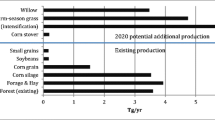Abstract
A GIS-based land evaluation model was developed to determine the food, feed, and fuelwood sufficiency of all districts in Nepal. Resource surpluses or deficits were calculated for each district for 1981, the year for which the national land resource data were available. Of the three resources, feed supplies were found to be the most critical. Feed deficits occurred in 57% of all districts in 1981, while food and fuelwood deficits occurred in less than 10% of all districts. Different scenarios were carried out for the year 2000 to estimate the magnitude of future resource deficits, assuming resource use and yields in Nepal remain constant in the face of growing population and livestock numbers. Linking resource data with spreadsheet and GIS systems provides a new way to understand and evaluate resources at the district and national levels. To more fully capture the usefulness of this approach, information on rates of change in productivity and land use is needed.
Similar content being viewed by others
Literature Cited
Asian Development Bank. 1982. Nepal agriculture sector strategy study, vol. II, detailed sector review and analysis. Asian Development Bank and HMG, December 1982, 220 pp. Appendix 2.3.
Environmental Resources Limited. 1988. Natural resource management for sustainable development. A study of feasible policies, institutions and investment activities with special emphasis on the hills. Environmental Resources Ltd., London, Interim Report for World Bank, November 1988, p. 20.
Hrabovszky, J. P., and K. Myan, 1987. Population growth and land use in Nepal, the great turnabout.Mountain Research and Development 7:264–290.
Ives, J. D., and B. Messerli. 1989. The Himalayan dilemma. Reconciling development with conservation. Routledge, London, 295 pp.
LRMP. 1986. The land resource mapping project in Nepal. Land systems, land utilization, agriculture, forestry, capability and economics report. HMG, Kathmandu, and Government of Canada.
Schreier, H., P. B. Shah, G. Kennedy, M. Schmidt, and C. Dunlop. 1989. Soils, sediments, erosion and soil fertility in Nepal. An evaluation of soil fertility and erosion with GIS techniques in the Jhikhu Khola watershed. Annual report to IDRC, 15 July 1989, 42 pp.
Schreier, H., P. B. Shah, and G. Kennedy. 1990. Evaluating mountain watersheds in Nepal using micro-GIS.Mountain Research and Development 10:151–159.
Shah, P. B., G. B. Nakarmi, A. K. Duvari, K. N. Tiwari, B. Shrestha, and H. Schreier. 1987. A resource evaluation of the Dhankuta district. Report to the Canadian International Development Agency (CIDA), by Integrated Survey Section, ISS, Topographical Survey Branch, HMG, Kathmandu, 15 December 1987, 66 pp.
Thompson, M., and M. Warburton. 1985. Uncertainty on a Himalayan scale.Mountain Research and Development 5:115–135.
Author information
Authors and Affiliations
Rights and permissions
About this article
Cite this article
Schreier, H., Brown, S., Kennedy, G. et al. Food, feed, and fuelwood resources of Nepal: A GIS evaluation. Environmental Management 15, 815–822 (1991). https://doi.org/10.1007/BF02394819
Issue Date:
DOI: https://doi.org/10.1007/BF02394819




